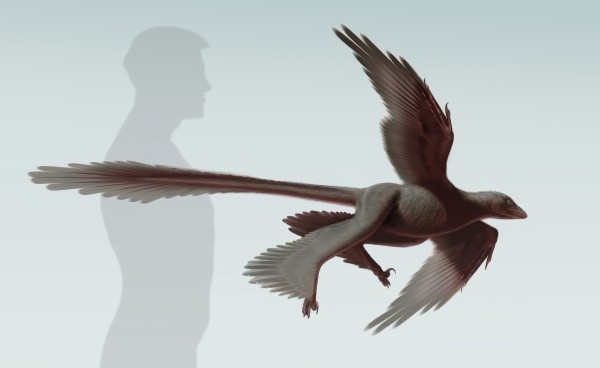New Species of "Four-Winged" Dinosaur Unearthed in China
| Kizha Trovillas | | Jul 18, 2014 11:51 PM EDT |
(Photo : Stephanie Abramowicz, Dinosaur Institute, NHM)
An exceptionally long-feathered fossil discovered in China is a new species of dinosaur that flew on four "wings."
The 125 million-year-old flying dinosaur called "Changyuraptor yangi" is the largest of its kind yet discovered. This flyer's tail feathers measure 30 cm long and are by far the longest feathers of any dinosaur known.
Like Us on Facebook
An international team led by the Natural History Museum in Los Angeles County discovered the fossilized dinosaur in Liaoning Province in northeastern China. The fossils belong to a four-foot-long adult raptor that weighed about nine pounds, researchers said.
Analysis of the raptor's bone structure show the fossils belonged to a fully grown adult. The fossil's sharp serrated teeth indicated it was a predator that fed on birds, fish and other small mammals.
"I've never seen anything like it," Luis Chiappe, a paleontologist of the Natural History Museum told the Washington Post.
"It is a stunning specimen and it was stunning to see the size of the feathers. There is nothing like this by a very good distance. The feathers were one-fourth the size of the animal."
"It's just wonderful," Chiappe added.
Changyuraptor is a part of Microraptorines, a group of predatory feathered dinosaurs that include few numbers of small four-winged species. The dinosaurs are called "four-winged" not because they have four wings but because their well-developed wings and long feathers attached to their hind legs give the appearance of four wings.
Researchers think the raptor's long feathered tail helped maintain balanced flight. An aerodynamic model to test the function of the tail found that the length of the tail feathers was important in reducing speed and ensuring safe landings.
The discovery of Changyuraptor has led to further knowledge into dinosaur flight, said a study in the bimonthly peer-reviewed scientific journal, Nature Communications.
It shows that these creatures were already flying before birds split-off from dinosaurs.
Tagschangyuraptor yangi, four-winged dinosaur, luis chiappe, natural history museum
©2015 Chinatopix All rights reserved. Do not reproduce without permission
EDITOR'S PICKS
-

Did the Trump administration just announce plans for a trade war with ‘hostile’ China and Russia?
-

US Senate passes Taiwan travel bill slammed by China
-

As Yan Sihong’s family grieves, here are other Chinese students who went missing abroad. Some have never been found
-

Beijing blasts Western critics who ‘smear China’ with the term sharp power
-

China Envoy Seeks to Defuse Tensions With U.S. as a Trade War Brews
-

Singapore's Deputy PM Provides Bitcoin Vote of Confidence Amid China's Blanket Bans
-

China warns investors over risks in overseas virtual currency trading
-

Chinese government most trustworthy: survey
-

Kashima Antlers On Course For Back-To-Back Titles
MOST POPULAR
LATEST NEWS
Zhou Yongkang: China's Former Security Chief Sentenced to Life in Prison

China's former Chief of the Ministry of Public Security, Zhou Yongkang, has been given a life sentence after he was found guilty of abusing his office, bribery and deliberately ... Full Article
TRENDING STORY

China Pork Prices Expected to Stabilize As The Supplies Recover

Elephone P9000 Smartphone is now on Sale on Amazon India

There's a Big Chance Cliffhangers Won't Still Be Resolved When Grey's Anatomy Season 13 Returns

Supreme Court Ruled on Samsung vs Apple Dispute for Patent Infringement

Microsoft Surface Pro 5 Rumors and Release Date: What is the Latest?










